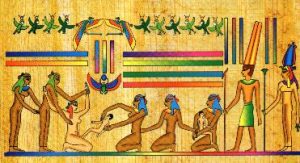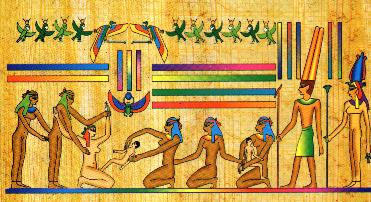DISEASES OF WOMEN AND CHILDREN:
Fertility was diagnosed by placing garlic in the vagina for one night. If the next day the woman can taste or smell it in her mouth, she is fertile. This is based upon the connection between the genital parts and interior of the body. Such connection would be lost in a case of obstructed Fallopian tubes. In modern medicine, phenolphthalein injected in the uterus would appear in urine based upon the same principle. A test known to gynecologists as “Speck’s test”.
Diagnosis of pregnancy and sex determination of the future child was based on the fact that pregnant urine germinates cereals more rapid then non-pregnant one. If the child was a male, the urine would germinate wheat, and if a female, it would geminate barley. The same tests have been used in Europe up till the Middle Ages.
Delivery was performed in the squatting position, with the woman supporting her arms on knees and sitting on two bricks. Difficult labors were aided by burning resin, or massaging the abdomen by saffron powder and beer. Abortions were done by introduction of warm oil and fat in the vagina. Contraception was also performed by the insertion of crocodile oil, gum acacia or honey consperge and natron into the vagina. Gum acacia when dissolved produces lactic acid, a very effective known spermicidal. The Ebers papyrus says
“To cause a woman to stop being pregnant, be it one, two or three years: part of acacia, colocynth, dates, finely ground in a hin of honey, fibers are moistened therewith, introduced into her vagina”.

The goddess Ritho giving birth to the god Ra assisted by midwives.
“Houses of birth” or “Mammisi” were annexed to temples. They were visited by pregnant women seeking divine help, rather than being a birth place.
Infants were breast fed for three years, and this was encouraged:
“Nothing is more lawful than one’s mother milk”.
Milk stimulants were resorted to, as mentioned in Ebers Papyrus:
“To bring forth the milk of a nurse who feeds sbj: who must feed a child: Spine of Nile-perch, fried in oil/fat, her spine is anointed therewith”.
Only when the mother failed to feed her infant, they resorted to cow milk.
SURGERY:
The Edwin Smith Papyrus shows the suturing of non-infected wounds with a needle and thread. Raw meat was applied on the first day, subsequently replaced by dressing of astringent herbs, honey and butter or bread. Raw meat is known to be an efficient way to prevent bleeding. Honey is a potent hygroscopic material (absorbs water) and stimulates the secretion of white blood cells, the natural first body defense mechanism. The application of sour or moldy bread was practiced in European medicine until the Renaissance. In AD 1928, Alexander Fleming extracted Penicillin from moulds, and 17 years later was awarded the Nobel Prize of Medicine.
At least 39 mummies with cancer have been identified. Cancer of the uterus has been described in the Ebers papyrus
“Another for one in whom there is eating on her uterus in whose vagina ulcers have appeared”.
Breast cancer was also described, but was non-curable.
“If thou examinst a man having bulging tumors on his breast, and if thou puttst thy hand upon his breast upon these tumors, and thou findst them very cool, there being no fever at all when thy hand touches him, they have no granulation, they form no fluid, they do not generate secretions of fluid, and they are bulging to thy hand. Thou shouldst say concerning him: One having bulging tumors. An ailment with which I will not contend”.
Two sculptured slabs from the 1st dynasty (3150 – 2925 BC) dating to kings Aha and Djer (2nd and 3rd kings) show a seated person directing a pointed instrument to the throat of another who was kneeling. Some Egyptologists believe it was a tracheotomy (opening the airways to maintain breathing) procedure.
The surgical treatment of abscesses or cysts was described in the Ebers Papyrus.
“Instructions for a swelling of pus …. A disease that I treat with knife-treatment. If anything remains in pocket, it recurs”.
Surgeons today are aware that complete excision of a swelling capsule is mandatory to avoid its recurrence.
Piles and rectal prolapse were treated by medication, suppositories, laxatives and enema. For burns, a mixture of milk of a woman who has borne a male child, gum, and, ram’s hair was applied. Urethral strictures were dilated using reeds. This was the earliest non-surgical intervention ever applied in history. In modern medicine, the first intervention was reported in the AD 1880’s by catgut balloons.
Mild antiseptics, as frankincense, date-wine, turpentine and acacia gum were used. Hot fire-drill was employed in cauterization.
Cairo museum has a collection of surgical instruments, including scalpels, scissors, copper needles, forceps, spoons, lancets, hooks, probes and pincers. A collection of 37 instruments is engraved on a wall in the temple of Kom-Ombo (2nd century BC), which was one of the houses of life. The Ebers Papyrus states
“thou shalt perform an operation for it, the same being split with a knife and sized with a …(? forceps)”.
The Edwin Smith Papyrus contains a list of instruments, including lint, swabs, bandage, adhesive plaster (x-formed), support, surgical stitches and cauterization.

Medical instruments.
Pain alleviation to allow surgery was known to ancient Egyptian physicians. Patients were sedated by opiates. Local anesthesia was also known, where water was mixed with vinegar over Memphite stone, resulting in the formation of carbon dioxide with its known analgesic effect. This is not too far from modern cryo-analgesia.
FRACTURES AND BONE DISEASES:
In a recent excavation close to the pyramids, the city of the craftsmen and builders of the pyramids was discovered. The remnants of their skeletons show simple and multiple limb fractures, mostly at the ulna and radius (forearm bones), and of the fibula (leg). Most of those fractures show signs of complete healing with good realignment of the bone, indicating that they had been set correctly with a splint. Possibly, traction was applied in humerus fractures (arm bone). Two skeletons show amputations (a left leg and a right arm) with healed bone ends, suggesting a successful surgery. Recently, American researchers have described a 23 cm screw, tying the thigh and calf bones, fixed into a mummy dating back to the 6th century BC. It could not be confirmed whether it was placed surgically or during embalming.

Fracture forearm with splint, from a mummy of the 5th dynasty, showing signs of healing.
An inscription in the tomb of Ipujy, an architect of the 19th dynasty (1300 BC) shows the physician – or sunu – reducing a dislocated joint. The procedure is exactly similar to the modern “Kocher’s technique” orthopedics use today.
The diagnosis of sciatic pain was well described in the Edwin Smith Papyrus:
“If thou examinst a man having a sprain in a vertebra of his spinal cord, thou shouldst say to him: extend now thy two legs and contract them both again. When he extends them both, he contracts them both immediately because of the pain he causes in the vertebra of his spinal column in which he suffers. Thou shouldst say concerning him: One having a sprain in a vertebra of his spinal column”.
This method of examination is what medical students today know as “Lassauge’s test”.
INTERNAL MEDICINE:
A good description of angina pectoris (heart attack) is demonstrated in the Ebers Papyrus:
“shouldst though examine a patient with stomach disease suffering from pain in the arms, in the breast, and on one side of the stomach, say: “Death threatens’” and “If thou examinst a man for illness in his cardia, and he has pains in his arm, in his breast, and in side of his cardia, and it is said of him: it is w3d illness, then thou shalt say thereof: it is due to something entering the mouth it is death that threatens him. Thou shalt prepare for him: stimulating herbal remedies …. “.
In our modern practice of cardiology nowadays, physicians are aware of the radiation of this type of pain, and its frequent mimic to stomach pain.
Cough was treated by inhalation of honey, cream, milk, carob, colocynth and date kernels. Some treatment of is mentioned in the Ebers Papyrus that is thought to be for asthma. The same papyrus describes an interesting apparatus for inhalation therapy:
“….. You should then bring 7 stones and heat them on fire. Take one of them, place parts of these drugs over it, cover it with a new jar with a pierced bottom. Introduce a tube of reed through this hole and put your mouth on this tube so that you swallow its fumes. The same with every stone … “.
Joint pain was treated by ointments containing fat, oil bone marrow, gum or honey as a base. To this were added flour, natron, onion, cumin, flax, frankincense or pine. Application of flax seed (Linseed) or animal fat (as snake or lizard) is still used today in the Egyptian countryside as an ointment for rheumatic pains. Diagnosis and treatment of gout were also described in the Ebers Papyrus
“Another to treat the toe if it is painful”.
The Edwin Smith Papyrus contains a description of the brain and its pulsation. Physicians were able to correlate it with paralysis. That was affirmed 1200 years before Hippocrates, the father of medicine, who thought the brain was nothing but a gland. The Ebers Papyrus has 12 prescriptions for headache, and three others in the Hearst Papyrus. One of those preparations was prepared by Isis herself to the god Ra:
“A sixth remedy that Isis made for Ra himself to eliminate the disease that is in his head: fruit of coriander …… made into a mass, honey is mixed with it, the head is bandaged therewith so that it goes immediately well with him”.
Migraine was considered a special entity and needed special notice. It was treated with the fish Siluris (an electric cat fish) in fat and oil.
Trepanning (making holes in the skull to relief pressure from within) was practiced in ancient Egypt. Numerous skulls at the faculty of medicine museum in Cairo show well- delineated circular holes in the frontal bones. Signs of perfect healing at the edges denote that the procedures were performed during life, and the patient survived enough time to allow healing. Examination of the overlying bone (and the scalp in a mummy) suggest that surgical procedures have been undertaken.
Remedies to cure constipation were abundant, in the form of
”Berries of castor oil tree, chew and swallow down with beer in order to clear out all that is in the body”.
If this was not effective, then add
“Leaves of castor oil plant 1/4, dates of male palm 5/6, Cyperus grass 1/16, stalk of Puppy plant 1/16, Coriander 1/16, cold beer 1/2, keep moist, strain,and take for four days”.
Diarrhea was stopped by
“Green onions 1/8, freshly cooked Gruel 1/8, oil and honey 1/4, wax 1/16, water 1/3, cook and take for four days”.




